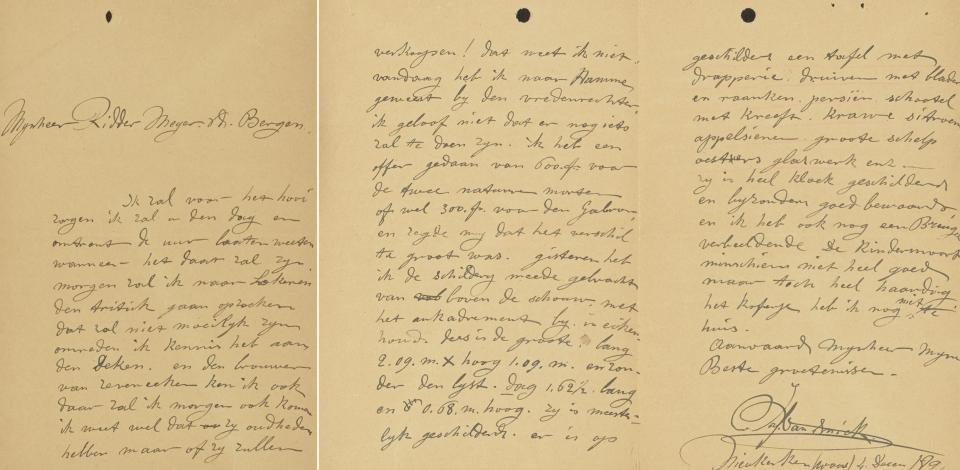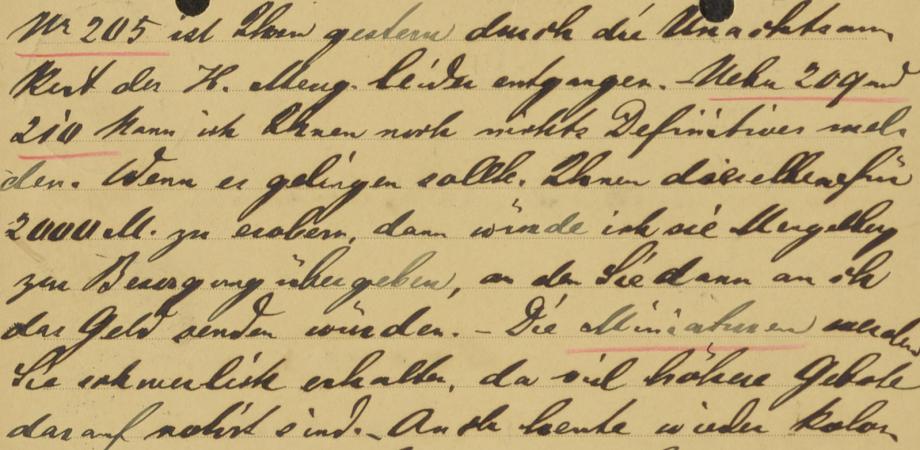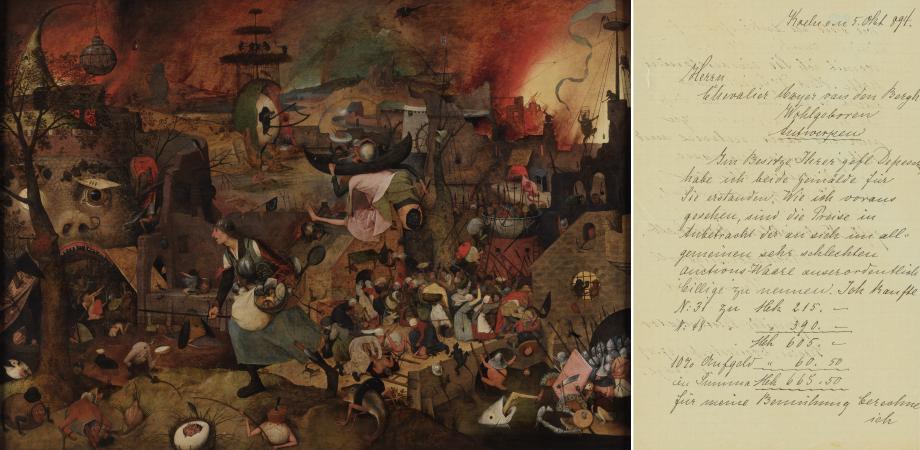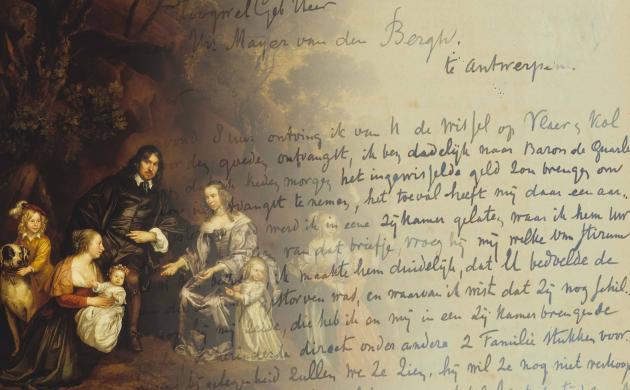Rediscovered artists
The name ‘Bruegel’ and its variants ‘Brueghel’ and ‘Breughel’ refer to a number of artists. All were related to each other. The oldest and also the best known is undoubtedly Pieter Bruegel the Elder (ca. 1525/1530 - 1569). Father Pieter Bruegel had two sons, Jan Brueghel the Elder (1568-1625) and Pieter Brueghel the Younger (1564-1638), who in turn became famous painters.

Jan Brueghel the Elder, ‘The Adoration of the Magi’, 1598 - 1600, oil on copper. MMB.0058. This is one of two works by Jan Brueghel the Elder that Fritz's father Emil Mayer purchased in 1865.
In the 19th century, the work of Pieter Bruegel the Elder and his family of painters was not well known to the general public. Their works were often held in inaccessible private collections. Certainly, the work of the ‘old’ Bruegel was also far from being appreciated by everyone.
Emil Mayer, Fritz's father, bought two paintings by Jan Brueghel the Elder from his uncle, the Cologne art collector Anton Joseph Essingh. Fritz was still a child at the time, but the purchase later sparked his interest in this family of artists. So when he decided to collect paintings in 1890, he immediately bought two works attributed to the Bruegel family.

Marten van Cleve, ‘Peasant Wedding in a Farmyard’, ca. 1550 - 1599, oil on oak. MMB.0053. Fritz probably bought this work under the assumption that Pieter Bruegel the Elder had painted it. Right: receipt from F. Van Hecke to Fritz Mayer van den Bergh, for a work ‘depicting a peasant feast’ (probably ‘Peasant Wedding’ by van Cleve), 15-12-1891 (MMB.A.0246).
The right works
The first two Bruegel works Fritz purchased in 1891 are not in the museum collection today under the Bruegel name. One of the paintings is a rural wedding scene. This is probably the Peasant Wedding in a Farmyard, which was attributed to Bruegel follower Marten van Cleve after Fritz's death.
The second Bruegel painting Fritz bought in 1891 was probably a copy of The Massacre of the Innocents by Pieter Bruegel the Elder. The intermediary who sold the painting described it as "maybe not very good but still very nifty." Fritz might have thought the work was of too low a quality; in any case, no version of The Massacre of the Innocents ended up in the final museum collection.

Pieter Bruegel the Elder, 'The Massacre of the Innocents, 1565-1567, Royal Collection, Windsor Castle. This is the original painting of which Fritz bought a copy.

Letter from Jozef van Snick to Fritz Mayer van den Bergh offering a copy of 'The Massacre of the Innocents', 4-12-1891 (MMB.A.0241).
Fritz's first acquisition that does sit in the museum collection as a Bruegel to this day is Pieter Brueghel the Younger's The Flight into Egypt. In 1894, Fritz sent his intermediary Alexander Schnütgen to Cologne to buy the work, but another collector offered a higher amount and outbid him. It would seem that Fritz was very keen to acquire this piece because he sent Schnütgen after the collector and eventually bought the painting for almost double the original price. The work in question is a copy of a painting by Pieter Bruegel the Elder that hangs in the Royal Museums of Fine Arts of Belgium in Brussels.

Pieter Brueghel the Younger, 'Winter landscape with a Bird Trap, and The Flight into Egypt', 1622, MMB.0055. Copy of the original by Pieter Bruegel the Elder from 1565.

Postcard from Alexander Schnütgen to Fritz Mayer van den Bergh regarding the auction of 'The Flight into Egypt', 5-06-1894 (MMB.A.0450).
That same year Fritz got his hands on his most important Bruegel acquisition. In a catalogue for an auction in Cologne, he noticed a painting attributed to Pieter Brueghel the Younger. However, Fritz recognised in the depiction a description by the 17th-century artist biographer Karel van Mander in which van Mander discussed the Dulle Griet (also known as Mad Meg), a painting by Pieter Bruegel the Elder that was considered lost at the time. He purchased the work for the modest sum of 488 francs. (That same year, a work by Rubens sold for 45,000 francs!) He immediately contacted renowned art historians, who confirmed to him that this was an authentic painting by Pieter Bruegel the Elder. Today, Mad Meg is still a highlight at the Museum Mayer van den Bergh!
In addition to these works, Fritz purchased five other Bruegels: The Twelve Flemish proverbs by Pieter Bruegel the Elder; The Census at Bethlehem by Pieter Bruegel the Younger; Flemish Ferry on the River Scheldt across from Antwerp, Village on a River, with a Ferry and The Adoration of the Magi' by Jan Brueghel the Elder.

Pieter Bruegel the Elder, 'Mad Meg', 1563. MMB.0045. Right: letter from Heinrich Fridt to Fritz Mayer van den Bergh containing the bill for the 'Dulle Griet', 5-10-1894 (MMB.A.0502).
Art in the archives
The archives provide a great insight into Fritz's collecting practice; they show, for example, that he did extensive research on the Bruegel works he wanted to buy or that he had already bought and that he was aware of developments in the art historical field. He was also in contact with the art historian Henri Hymans, who at the end of the 19th century was considered the leading expert on Pieter Bruegel the Elder. The archive-based research, however, also leads to new questions. What were Fritz's considerations for buying or not buying certain paintings? How were these decisions connected to Fritz's own ideas about Bruegel?
The archive helps us look at such issues in a new way and brings us closer to the collectors’ scene in which Fritz went in search of the Bruegel family.



